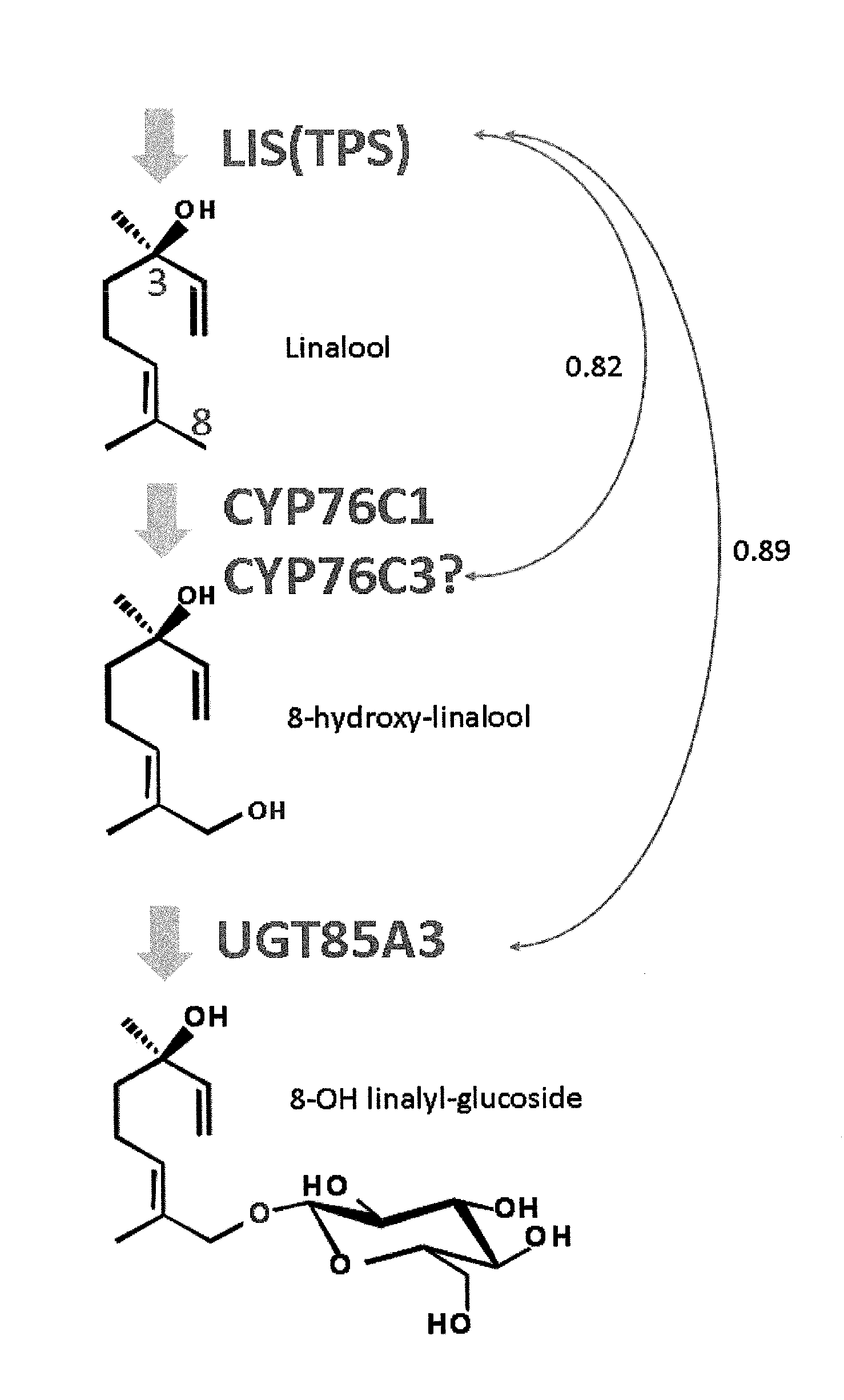Method for utilizing monoterpene glycosyltransferase
a monoterpene glycosyltransferase and glycosylation technology, which is applied in the direction of transferases, bulk chemical production, plant/algae/fungi/lichens ingredients, etc., can solve the problems that the molecular mechanism of sugar addition (i.e., glycosylation) in monoterpenes has not yet been identified
- Summary
- Abstract
- Description
- Claims
- Application Information
AI Technical Summary
Benefits of technology
Problems solved by technology
Method used
Image
Examples
example 1
Isolation of Candidate Genes
[0142]The molecular biological procedures used in this example were in accordance with the methods described in Molecular Cloning (Sambrook, et al., Cold Spring Harbour Laboratory Press, 2001), unless detailed elsewhere.
[0143]Arabidopsis thaliana is reported to show accumulation of a compound having glucose added to the hydroxyl group at the 8-position of linalool, a kind of monoterpene (FIG. 1) (Non-patent Document 1). Based on the hypothesis that synthesis of linalool and glycosylation of linalool occur in a synchronized manner in terms of the time and space, a gene to be co-expressed with linalool synthase (S-linalool synthase (LIS): At1g69680) in Arabidopsis thaliana was examined by ATTED-II co-expression analysis (http: / / prime.psc.riken.jp / ?action=coexpression_index). As a result, from among one hundred and several tens of candidate genes, UGT85A3 (At1g22380) was found as a candidate UGT gene showing high correlation with linalool synthase at an expr...
example 2
Construction of UGT85A3 Expression Vector
[0144]The full-length ORF (SEQ ID NO: 5) of UGT85A3 was amplified by PCR with the following primers designed to have restriction enzyme sites (SEQ ID NOs: 6 and 7). It should be noted that the underlined nucleotide sequences in the primers are restriction enzyme recognition sequences added to the primers.
[0145]
UGT85A3 cDNA (At1g22380):(SEQ ID NO: 5)ATGGGATCCCGTTTTGTTTCTAACGAACAAAAACCACACGTAGTTTGCGTGCCTTACCCAGCTCAAGGCCACATTAACCCTATGATGAAAGTGGCTAAACTCCTCCACGTCAAAGGCTTCCACGTCACCTTCGTCAACACCGTCTACAACCACAACCGTCTACTCCGATCCCGTGGGGCCAACGCACTCGATGGACTTCCTTCCTTCCAGTTCGAGTCAATACCTGACGGTCTTCCGGAGACTGGCGTGGACGCCACGCAGGACATCCCTGCCCTTTCCGAGTCCACAACGAAAAACTGTCTCGTTCCGTTCAAGAAGCTTCTCCAGCGGATTGTCACGAGAGAGGATGTCCCTCCGGTGAGCTGTATTGTATCAGATGGTTCGATGAGCTTTACTCTTGACGTAGCGGAAGAGCTTGGTGTTCCGGAGATTCATTTTTGGACCACTAGTGCTTGTGGCTTCATGGCTTATCTACACTTTTATCTCTTCATCGAGAAGGGTTTATGTCCAGTAAAAGATGCGAGTTGCTTGACGAAGAGATACTTGGACACAGTTATAGATTGGATACCGTCAATGAACAATGTAAAACTAAAAGACATTCCTAG...
example 3
Enzyme Expression and Purification
[0149]To clarify biochemical functions of this enzyme, this enzyme was allowed to be expressed in E. coli cells. The UGT85A3 E. coli expression plasmid obtained above was used to transform E. coli strain BL21(DE3) in a standard manner. The resulting transformant was cultured overnight at 37° C. under shaking conditions in 4 ml of a 50 μg / ml ampicillin-containing LB medium (10 g / l typtone pepton, 5 g / l yeast extract, 1 g / l NaCl). After reaching the resting phase, the cultured solution (4 ml) was inoculated into a medium of the same composition (80 ml) and cultured at 37° C. under shaking conditions. At the time point where the cell turbidity (OD600) reached about 0.5, IPTG was added at a final concentration of 0.5 mM, followed by culturing at 18° C. for 20 hours under shaking conditions.
[0150]The following manipulations were all performed at 4° C. The cultured transformant was collected by centrifugation (5,000×g, 10 min) and then added to and suspen...
PUM
| Property | Measurement | Unit |
|---|---|---|
| pH | aaaaa | aaaaa |
| temperature | aaaaa | aaaaa |
| temperature | aaaaa | aaaaa |
Abstract
Description
Claims
Application Information
 Login to View More
Login to View More - R&D Engineer
- R&D Manager
- IP Professional
- Industry Leading Data Capabilities
- Powerful AI technology
- Patent DNA Extraction
Browse by: Latest US Patents, China's latest patents, Technical Efficacy Thesaurus, Application Domain, Technology Topic, Popular Technical Reports.
© 2024 PatSnap. All rights reserved.Legal|Privacy policy|Modern Slavery Act Transparency Statement|Sitemap|About US| Contact US: help@patsnap.com










